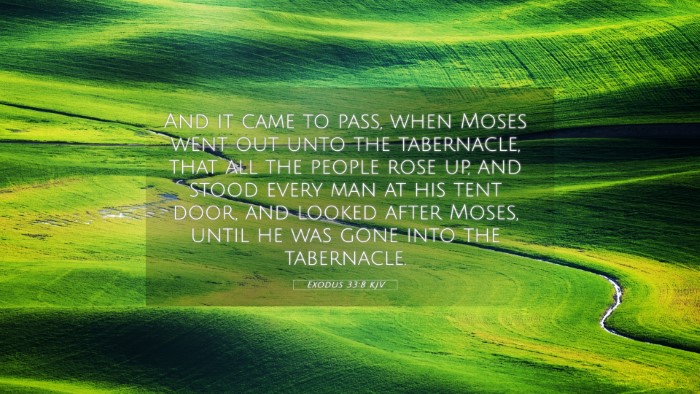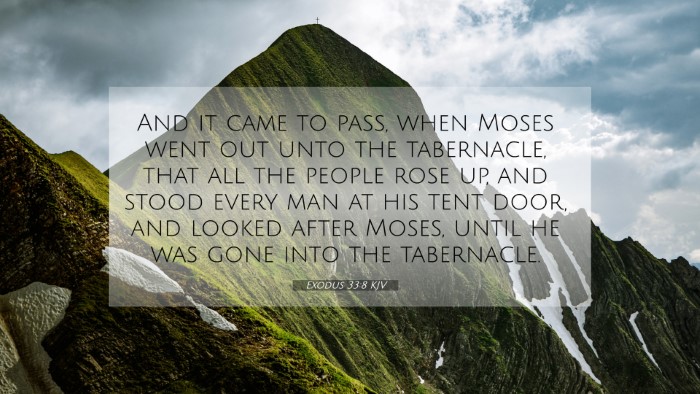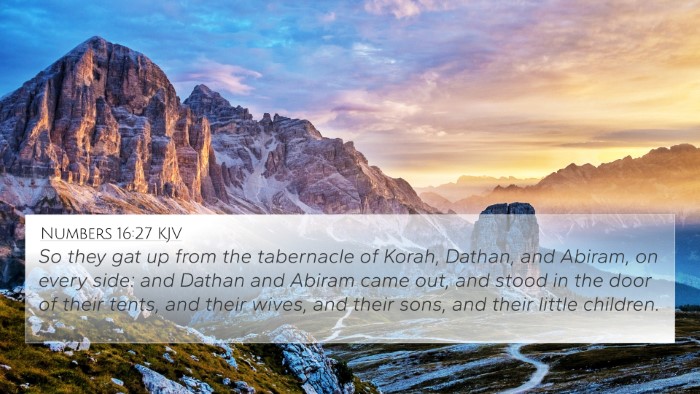Understanding Exodus 33:8
Exodus 33:8 states:
"And it came to pass, when Moses went out unto the tabernacle, that all the people rose up, and stood every man at his tent door, and looked after Moses, until he was gone into the tabernacle."
Contextual Overview
This verse occurs in a pivotal moment in the narrative of the Israelites' journey through the wilderness after the Exodus from Egypt. Moses, as the mediator between God and the Israelites, had set up a tent outside the camp, known as the tabernacle of meeting, where he would communicate with God.
Verse Meaning and Significance
Various commentaries such as those by Matthew Henry, Albert Barnes, and Adam Clarke offer insightful interpretations of this verse:
-
Matthew Henry:
Henry remarks on the importance of Moses’s role as the leader who intercedes for the people. His entering the tabernacle signifies a profound connection with God, which the Israelites observe with reverence and anticipation.
-
Albert Barnes:
Barnes emphasizes the collective action of the Israelites who stood at their tent doors, highlighting their expectation for God's guidance through Moses. This reflects their dependence on divine direction and their recognition of Moses' unique relationship with God.
-
Adam Clarke:
Clarke focuses on the faithfulness of the people evidenced by their actions. His commentary points out that their standing at the door represents a posture of waiting and yearning for the God of their forefathers, emphasizing their need for spiritual leadership.
Cross-References and Thematic Connections
This verse can be connected to several other passages which reflect similar themes:
-
Numbers 12:7-8: Moses is described as faithful in all God's house, emphasizing his unique role as God’s spokesperson.
-
Exodus 33:11: The Lord spoke to Moses face to face, a testament to their direct communication and the unique relationship.
-
Deuteronomy 34:10: There has not arisen a prophet since in Israel like Moses, indicating his unparalleled status among the people as a leader and prophet.
-
Hebrews 3:5-6: Reflects on Moses' faithfulness as a servant, paralleling his role in the Old Testament with the understanding of Christ in the New Testament.
-
2 Corinthians 3:13-14: Paul talks about the glory of the Old Covenant, which Moses brought, and how it was fading compared to the New Covenant.
-
Matthew 17:3: The transfiguration of Jesus, where Moses appears, linking the Old Testament figures with the New Testament revelation of Christ.
-
Acts 7:37: Refers to Moses as a prophet, affirming his role as a lawgiver and leader who foreshadows future prophetic figures in the faith.
Concluding Insights
In summary, Exodus 33:8 captures a significant moment wherein Moses acts as a mediator and leader, drawing the attention of the Israelites toward divine communication, thus weaving connections essential for understanding God’s ongoing interaction with His people. The collective anticipation of the people reflects a deep-seated need for guidance, a recurring theme throughout the Scriptures. Each referenced verse enriches the exploration of God's covenantal relationship with His people, establishing a thematic dialogue between the Old and New Testaments.
Tools for Cross-Referencing Bible Verses
For further study, several resources can be employed:
- Comprehensive Bible concordances
- Bible cross-reference guides
- Online Bible tools for cross-referencing
- Study Bibles that include cross-references
- Bible reference resources highlighting thematic connections



